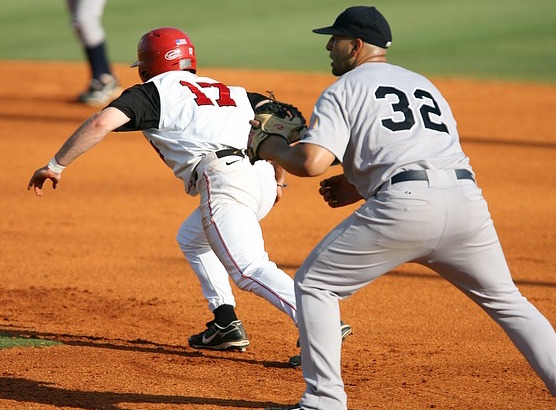Stealing on first-move (Part 1)
September 14, 2017 by Coach McCreary
Filed under Base Running, Coaching, First Base, Pitching
This is Part 1 of a three part series on stealing second base using the “first-move” method. Today I’ll focus on what stealing “first-move” means and why a coach/runner would do it.
Up first is What does it mean to steal on first-move?
Stealing on a pitcher’s first-move involves a runner who breaks towards second base as soon as a left-handed pitcher moves after coming set in the stretch position. When the pitcher moves (usually it means lifting the lead foot) it could be the start of a pitch thrown to the plate or it could be the start of a pick-off move to first base. When the runner breaks on first-move, he really doesn’t care whether the pitcher throws home or to first base. To some, this may seem like a big gamble. If he guesses right on the first-move, the pitcher throws home and the runner easily steals second base. If he guesses wrong, the runner is picked-off. On the surface it may seem like a 50-50 gamble. However, if you do your homework thoroughly before the play, you can drastically turn the odds in your favor.
And that brings us to the “why’s” of stealing first-move.
We’ve all seen left-handers with tremendous pick-off moves to first base. These pitchers can be very difficult to steal on in the traditional way so coaches will often apply different strategies to up their odds. Plays such as the delayed steal and hit-and-run are often used in order to decrease the chances of the runner getting picked off while still retaining the benefit of putting the runner in motion. Another strategy with some left-handers is to go immediately upon his first-move.
Left-handers use different methods to throw the ball to first base on pick-off attempts. Some step directly to first and throw after coming set. Others throw after stepping on a 45 degree angle towards home plate in order to deceive the runner. Some make a quick delivery to first and others take a long, slow step towards first. The first-move strategy is a good one for the last one mentioned … the long, slow pick-off delivery to first base.
For this strategy, the coach and/or base runner at first is betting that he can sprint to second base faster than the defensive team’s ability to throw to first base and then second to nail the runner.
It sounds very simple to throw to first and then to second to nail the runner. However, when you break the entire play down to see all the things that have to happen for the runner to be out, it becomes anything but simple.
- The pitcher’s throw needs to be accurate and easy to handle for the first baseman.
- The first baseball has to catch the ball.
- The first baseman has to quickly remove the ball from his glove with a proper, secure grip.
- The first baseman needs to shift his feet properly and quickly to get his body positioned to make the throw to second.
- The first baseman needs to make a strong, accurate throw to second that avoids the runner.
- The middle infielder (usually the shortstop) needs to quickly see what’s happening and be at second base in time to receive the throw.
- The shortstop has to position his feet correctly on the proper side of the bag to make the catch.
- The shortstop has to catch the ball.
- The shortstop has to apply a quick and accurate tag and hold onto the ball in the process.
Along with every step the defense has to complete comes the possibility of mistakes and miscues involving timing, footwork, accuracy, and so forth. In comparison, the runner just needs to do two main things – sprint to second and slide.
Of course, just like the defense, the coach and/or the runner has some little things they have to be aware of and do correctly for the first-move steal to work.
That’s what I will discuss in Part 2.






Coach,
I have to disagree that the delayed steal is viable alternative to straight-stealing versus a left hand pitcher.
I’m a huge proponent of the delayed steal. We primarily do it with two outs, when the opposing middle infielders are playing far from the bag (“big infield”).
But it’s a bad risk against a lefthander because our delayed steal depends on our runner getting an aggressive “gain ground” secondary lead, which is not smart to do versus a lefthander because a throwover would catch our baserunner flat-footed in “no man’s land.”